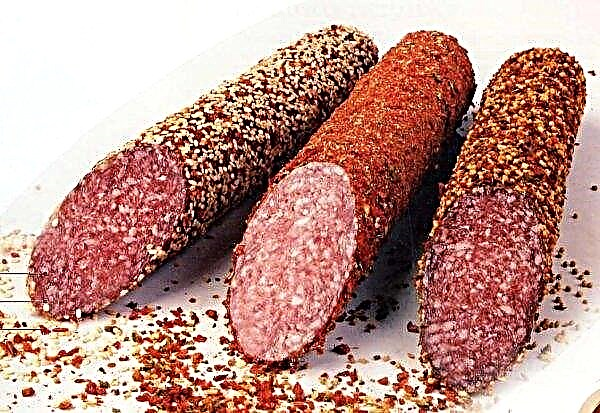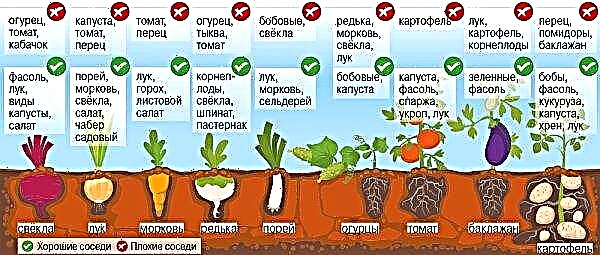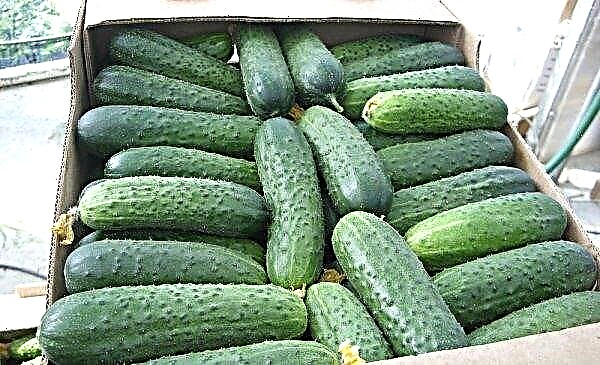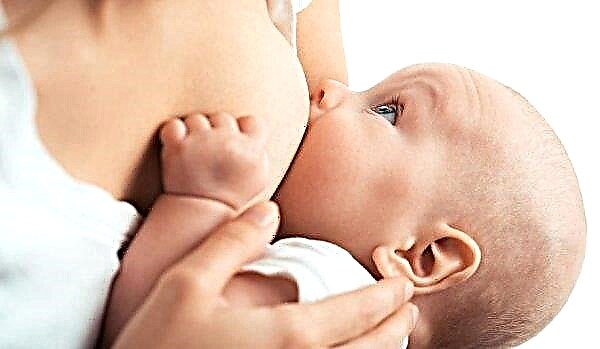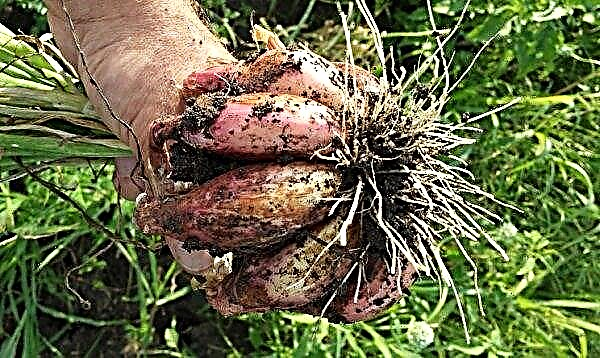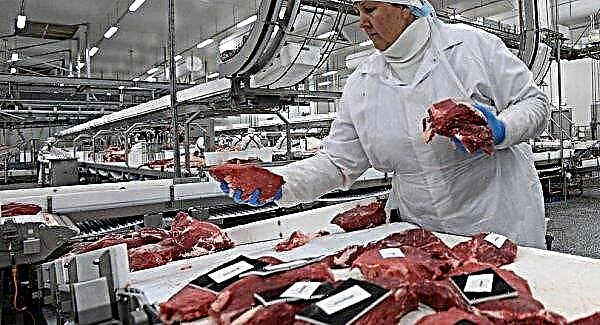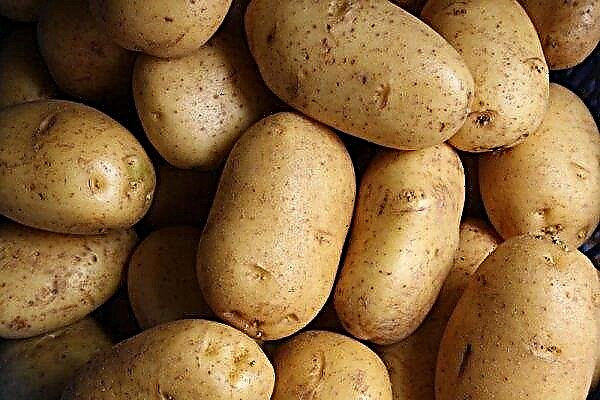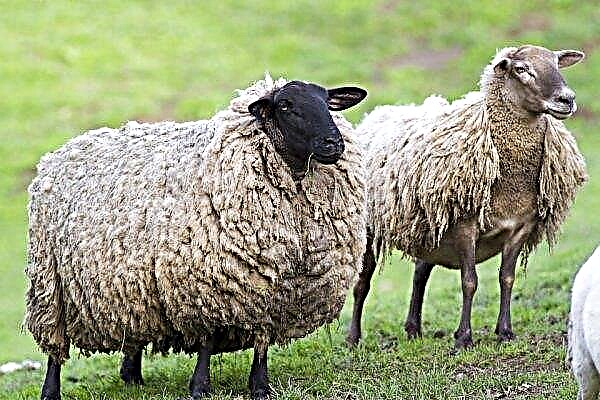Poor egg production of chickens is not the only problem associated with their productivity. In some cases, eggs appear stably, but their quality is far from ideal, and the reason for this is not only an insufficient amount of nutrients inside the egg, but also a too soft shell on the outside. What contributes to the appearance of "soft" eggs and how to solve this problem - we will talk about this in this article.
Why do chickens lay eggshells?
In fact, there are plenty of reasons for softening the hard shell of chicken eggs, and the first “suspect” is an unbalanced diet. However, if everything is in order from the chicken menu, and you are sure of sufficient intake of vitamins and minerals in their body, then you should think about possible hormonal imbalances or the development of diseases. By identifying the specific cause of the violation, it will be easier to deal with it.
Did you know? Sometimes two yolks can be found in one egg, which is considered a rather rare anomaly. In this regard, a lot of folk signs have appeared: some promise good luck to those who have found such an unusual testicle (for women - the quick birth of a child), while others promise grief in the family.
Poor diet
Important minerals such as:
- manganese;
- zinc;
- cobalt;
- copper;
- calcium;
- iodine;
- sodium;
- iron;
- phosphorus.
A considerable amount of sodium is contained in table salt, so this product is useful to use when preparing wet mixes (0.5 g per 1 chicken will be enough). Calcium is a significant part of the composition of shellfish and chalk, therefore, in a crushed version, they can also be introduced into the diet of birds. In summer, laying hens usually do not lack nutrients, because they get almost everything they need with green fodder and wheat.
In summer, laying hens usually do not lack nutrients, because they get almost everything they need with green fodder and wheat.
In winter, compound feed mixtures help to partially solve the problem of balanced nutrition, but this is only if they contain diverse components: ground corn, wheat (at least 20%), barley, sunflower meal, meat and bone, fish or grass meal, yeast, peas, salt (not more than 3 g per day), vitamin complex.
Hormonal disorders
The whole process of egg formation is controlled by the nervous system, and not without the participation of hormones. So, in a stressful state, normal egg maturation is immediately impaired, and this is one of the main reasons for the appearance of specimens without shells. The whole process of egg formation is as follows:
- In the ovaries, hens form and mature eggs.
- Then they enter the oviduct, and later into the genital tract.
- In the presence of a rooster, fertilization occurs, and if it is not, then all the necessary shells (protein, yolk, shell) are simply formed.
 Immediately after the first, the second egg matures, which will very soon be ready for exit. However, it also happens that in the oviduct there are several eggs at once, because of which an egg with two yolks or two separate eggs is formed, but the second simply does not have the upper covering material - the shell.
Immediately after the first, the second egg matures, which will very soon be ready for exit. However, it also happens that in the oviduct there are several eggs at once, because of which an egg with two yolks or two separate eggs is formed, but the second simply does not have the upper covering material - the shell.Usually this phenomenon is not considered pathological, but if the layers are kept in unsuitable conditions for life and are constantly nervous, then their eggs will almost always be “problematic”. Violations can be observed in the case of the use of unsuitable feeds or additives, especially those containing hormones.
Diseases
In the chicken world there are many diseases that lead to one or another deviation in the productivity of birds, but if we talk about the absence or softening of the eggshell, then it is likely that the following ailments will be the cause.
Infectious bronchitis
Even experienced poultry farmers cannot always accurately diagnose infectious bronchitis in layers, because its symptoms can be easily confused with the manifestations of some other diseases: for example, sinusitis, bronchopneumonia, hemophilosis. This ailment is of a viral nature, today there are already about 30 strains of viruses, any of which can cause egg laying disorders in chickens. From the moment the virus enters the body of the chicken and until the first manifestations of the disease, 3 to 10 days usually pass, after which they appear Signs of a respiratory viral infection:
From the moment the virus enters the body of the chicken and until the first manifestations of the disease, 3 to 10 days usually pass, after which they appear Signs of a respiratory viral infection:
- lethargy, apathy;
- labored breathing;
- loss of appetite;
- chills.
Important! In addition to chickens, other agricultural and domestic animals or even the person himself can suffer from viral bronchitis, therefore, when dealing with sick individuals, it is very important to observe personal preventive measures.
Newcastle disease
Vertichka (another name for the disease) develops as a result of exposure to the chicken body of the paramyxovirus PMV-1, which today has a large number of different strains. They "mask" Newcastle disease under the bird flu, bronchitis or cholera, and only accurate laboratory diagnostics will help to exclude all these options and confirm the guesses.
There are acute, subacute, nervous, respiratory and atypical forms of Newcastle disease, and each of them is characterized by its own characteristics of the course. The most common symptoms for all of these forms are the following symptoms:
- apathy;
- refusal of food;
- the appearance of loose stools;
- secretion of mucus from the eyes and nose;
- paresis of limbs;
- respiratory failure;
- decreased egg production and ability to reproduce.
 Thinning of the shell or other deformation processes of the eggs is more characteristic of the atypical and respiratory forms, but in the acute course of the disease, such features simply do not have time to notice (the birds die within a few days).
Thinning of the shell or other deformation processes of the eggs is more characteristic of the atypical and respiratory forms, but in the acute course of the disease, such features simply do not have time to notice (the birds die within a few days).Mycoplasmosis
Another viral disease that spreads rapidly around the chicken coop. First of all, it affects the respiratory system of birds, and later affects the organs of the reproductive system.
The incubation period of the disease is 20 days, but this does not mean that laying hens without visible symptoms will be safe for the rest of the livestock, therefore, at the first suspicion, it is better to remove an unhealthy individual from its relatives for a while.
There are four stages of mycoplasmosis: latent, the appearance of the first mild symptoms (observed only in 10% of the bird), the appearance of the main symptoms and its smoothing, when the diseased laying hen can be considered an active carrier of infection. The main signs of the development of the problem include:
- the appearance of cough and wheezing;
- labored breathing;
- swelling of the eyelids and redness of the eyes;
- loss of appetite
- yellow or greenish diarrhea;
- decrease in egg production (up to 15%);
- damage to the oviduct and cornea.

Bird flu
An acute infectious disease that affects all organs and systems of the chicken body during the first 20-30 hours after exposure to the virus. In the absence of adequate treatment at the initial stage of the development of the disease, it will lead to death.
Did you know? According to preliminary estimates, the total number of chickens on the planet is 3 times the number of people, and although it is still not clear how people made these calculations, it is obvious that the majority of birds live in Asian countries.
The main symptoms of the disease are the following changes in the behavior and appearance of birds:
- decreased appetite;
- sneezing and lacrimation appear;
- oviposition is disrupted and the number of eggs laid is reduced (some of them have soft shells);
- plumage dims;
- breathing is disturbed;
- the scallop blue and swelling are clearly visible;
- coordination of movements is lost;
- diarrhea appears.
 Avian flu is also dangerous for humans, causing a sore throat, cough, fever, muscle pain, and other characteristic symptoms of a cold or flu. Pneumonia or other complications may develop, but in general the disease is more complicated than when infected with standard human types.
Avian flu is also dangerous for humans, causing a sore throat, cough, fever, muscle pain, and other characteristic symptoms of a cold or flu. Pneumonia or other complications may develop, but in general the disease is more complicated than when infected with standard human types.Important! Eggs and meat from infected birds should not be eaten. All products are recyclable.
Egg Drop Syndrome
The incubation period of this disease lasts from 1 to 15 days and is accompanied by a sharp decrease in egg production by 20–28%. In addition, the resulting eggs have a loose surface and can be spotty.
The clinical picture is rare, and only some owners report a deterioration in the condition of chickens, manifested in poor appetite, anemia, anorexia, blue scallop and catkins. Pathological changes are expressed in swelling and infiltration of the uterus and oviduct of the bird, a small catarrhal enteritis. An accurate diagnosis can only be made on the basis of laboratory studies, with the obligatory taking into account epizootological data, available symptoms and pathological changes.
An accurate diagnosis can only be made on the basis of laboratory studies, with the obligatory taking into account epizootological data, available symptoms and pathological changes.
What to do if chicken eggs have a thin shell
Timely prevention helps to save chickens from possible problems: vaccination against common ailments, maintaining cleanliness in the chicken coop and observing the requirements for a complete diet. However, if it was not possible to avoid problems, it is important to make a diagnosis in time and start treatment.
Disease treatment
Above, we have already examined the most common diseases that adversely affect the condition of chickens and their productivity. Now I want to pay attention to the issue of their treatment.
Infectious bronchitis. There is no well-developed treatment regimen for the disease, so the main work is aimed at eliminating the symptoms. For this purpose, the following drugs can be used:
- Anfluron - An antiviral agent with a wide spectrum of action. For one individual, 0.5-1 ml of the composition per day (drink or injected into the body intramuscularly). The course of treatment is from 7 to 30 days.
- "Blue iodine" - It fights well with pathogens of respiratory infections. One chicken requires 0.2-0.5 ml of the drug per day, and the medicine can be evaporated with water or given out in pure form.

- Disinfection of the room using appropriate solutions: chloroskipidar, glutex, vircon C, aluminum iodide, Lugol's solution (in the latter case, not only the room is processed, but also the bird itself by irrigation of its beak and nostrils). When diagnosing the first signs of infectious bronchitis, chicken coop processing is performed at least once every two weeks.
Newcastle disease. In this case, it is not the treatment itself that is effective, but the prevention of the disease, which involves the use of a live vaccine with a streptogenic strain of the virus (usually these are drugs from strain “H”, “B1”, “Bor-74” and “La-Sota”). To limit the spread of the virus, all diseased birds are subject to immediate destruction, and the room itself is treated with ultraviolet radiation.
Important! Together with therapeutic measures, a daily survey of the livestock is carried out in order to separate the sick and weakened birds from the herd.
Mycoplasmosis At the first symptoms of the manifestation of this disease, it is appropriate to do antibiotic therapy using the following drugs:
- Farmazin - 1 g is dissolved in 1 liter of water.

- Tylosin - 0.5 g per 1 liter.

- Tilsol-200 - 2.5 g per 1 liter.
- Enroflox - 1 ml per 1 liter.
Important! The amount of all ingredients in both recipes is calculated for 1 kg of finished feed, so for a larger dose you will have to calculate a different ratio of components.
In cases where there is no certainty in the diagnosis, it is better to use drugs of complex effect, in which, in addition to the antibiotic, there is a whole set of other bacteria. Some of the most effective such drugs are:
- "Biopharm" - 2.5–70 g per thousand heads (depending on the specific age of the birds).
- Tilodox - 1 ml per 1 liter of water.
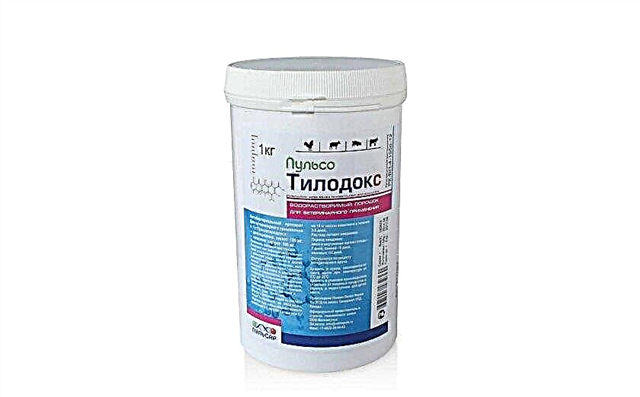
- Tilokol - 4 g per 1 kg of feed.
- Eriprim - 1 g per 1 liter of water.
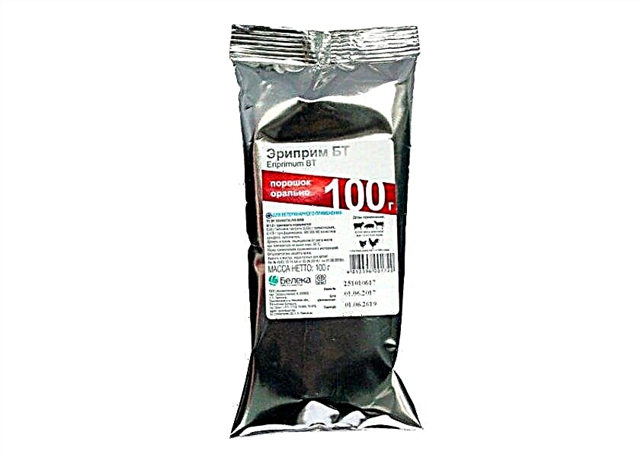
Bird flu. Unfortunately, there is still no effective treatment regimen in the fight against this ailment, which is explained by the rapid spread and mutation of the virus. That is, a vaccine that can help today will be ineffective tomorrow, which is why farmers prefer to simply get rid of diseased individuals, by all means limiting the spread of infection in the house.
Syndrome of egg production. Typically, to solve the problem, normalizing the diet and improving the conditions of chickens, with the organization of regular walks in the fresh air, is enough. However, in advanced cases, it is worth paying attention to the possibility of using a liquid inactivated vaccine against SSW-76 and associated inactivated Avivak vaccines (effective against IBK, SSYA-76, NB, REO).
Change in diet
The daily menu of laying hens should include the most diverse in composition food, because only in this way can the feathered organism be saturated with a sufficient amount of all the minerals and trace elements it needs.
To the usual wheat and sunflower meal, you can add meat and bone or limestone flour, barley, peas, table salt and some other components available to you. There are many recipes for optimally balanced food, and here are some of them:
Option 1
| Product | Recommended Amount (g) |
| Wheat | 625 |
| Limestone flour | 75 |
| Sunflower meal | 175 |
| Fodder yeast | 25 |
| Meat and bone meal | 40 |
| Mineral and Vitamin Supplements | 20 |
| Salt | 10 |
| Baking soda | 20 |
| Sunflower oil | 25 |
Option 2 (cereal-based feed mixture)
| Product | Recommended Amount (g) |
| Wheat | 120 |
| Corn | 450 |
| Peas | 70 |
| Barley | 120 |
| Sunflower meal | 70 |
| Salt | 1,5 |
| Herbal flour | 20 |
| Vitamin and Mineral Supplements | 150 |
Usually, poultry farmers do not have problems with what to feed the bird, however, if enough vitamin products were not prepared during the summer season, then you will have to consider the use of ready-made feed mixtures, in addition to which vitamin and mineral complexes are often used (what exactly can be given can be decided after consultation with a veterinarian).
Vitamin therapy
At first glance, the prevention or even treatment of chicken diseases using vitamins seems to be an ineffective way to solve the problem, because when the bird is saturated with nutrients, its resistance to infectious and bacterial ailments increases significantly.
If you yourself are preparing feed mixtures for your feathered pets, then make sure that they include such components:
- limestone;
- a piece of chalk;
- shell rock;
- ash;
- bone meal (at least 1 g per head);
- phosphates;
- fish oil (well compensates for the deficiency of vitamin D, therefore indispensable for keeping chickens indoors).
 Together, these products will serve as a good source of calcium, iodine, phosphorus, copper, manganese, zinc, vitamins A, C, E, D, group B, which is necessary for laying hens.
Together, these products will serve as a good source of calcium, iodine, phosphorus, copper, manganese, zinc, vitamins A, C, E, D, group B, which is necessary for laying hens.Do not also forget that the chicken body processes only half of the vitamins that have got into it, therefore, when calculating the required dosage of useful components, it is advisable to take a little more.
Other possible problems
The thin shell of chicken eggs is not the only problem of their quality. Poultry farmers often have to deal with such unpleasant phenomena as a bloodied shell surface, limescale or shell deformation. Of course, in each case there is an explanation of what is happening, so it is worthwhile to carefully examine the root causes of such a phenomenon.
Bloody eggs
Contrary to popular belief, the appearance of blood on the shell of an egg does not always indicate the presence of pathological changes in the body of a laying hen. It is likely that such an egg was laid by a youngster, who only recently began active laying, which means that over time there will be no bloody discharge. However, if we are talking about an experienced chicken, then the appearance of blood on the shell or even inside the egg can be explained by an excess of protein in the diet of the bird, which, accordingly, is solved by revising the diet.
However, if we are talking about an experienced chicken, then the appearance of blood on the shell or even inside the egg can be explained by an excess of protein in the diet of the bird, which, accordingly, is solved by revising the diet.
As for diseases, one of the most obvious ailments that can lead to the appearance of bloodied eggs is coccidiosis, and if such a phenomenon has become widespread, most likely an epidemic has begun in the chicken coop, requiring immediate treatment of the entire livestock.
Lime or Rough Eggs
Normally, the surface of the chicken egg should be completely flat, but sometimes poultry farmers collect specimens with a corrugated or "point" surface of the shell. This is often explained by violations in the body of the laying hen at the stage of egg formation (a hormonal reason is possible) or changes in the body due to a lack of incoming nutrients.
For example, a lack of calcium can manifest itself not only by thinning the shell over the entire surface of the egg, but also by its uneven density: in some places the layer is thicker, in others it is much thinner. If there are no symptoms of the disease, a review of the diet will be enough to solve the problem.
Important! As in previous cases, the "wrong" eggs can be eaten without fear for their quality.
Deformed eggs
Chicken eggs are oval products, sometimes with one side slightly elongated. The appearance of irregularities on the shell or a change in the usual shape (the egg seems crumpled) may indicate a trauma that the chicken received during the formation of the egg in the oviduct. It is likely that even there a crack formed on it, which later took shape in a crease or unevenness. The second possible reason for the appearance of deformed eggs is the old age of the chicken or the presence of pathologies of the internal organs caused by diseases or vaccination.
The second possible reason for the appearance of deformed eggs is the old age of the chicken or the presence of pathologies of the internal organs caused by diseases or vaccination.
Preventive measures
A thin shell is not considered a serious pathology, but such a phenomenon can not be called a norm, so you should make every effort to strengthen the eggs. In this case, preventive measures include the implementation of several simple actions (apart from a well-balanced diet):
- A few months before laying, start adding nutrients (especially calcium) to the bird feed.
- To develop a sufficient amount of vitamin D in the feathered organism, do not forget to organize a spacious walk in a well-lit area, where in the summer, laying hens can spend most of their day.
- Take care of the prevention of infectious bronchitis and other diseases characteristic of poultry in farms with violations of the conditions of detention (timely vaccination will help to achieve the maximum result).
- Do not seek early masonry from young laying hens.
- Adhere to a certain regime in the issuance of feed and daily routine of poultry.
- Change the litter in the chicken house in a timely manner: it should always be fresh and of high quality.
 Simply put, the owner of the birds is only required to observe the general rules for keeping and feeding chickens, and then the likelihood of the appearance of "wrong" eggs with a thin shell will be minimal. You should not focus on this excessive attention, but if a problem arises, it’s still worth trying to solve it in the simplest and most affordable ways: normalizing food and the daily regimen.
Simply put, the owner of the birds is only required to observe the general rules for keeping and feeding chickens, and then the likelihood of the appearance of "wrong" eggs with a thin shell will be minimal. You should not focus on this excessive attention, but if a problem arises, it’s still worth trying to solve it in the simplest and most affordable ways: normalizing food and the daily regimen.






